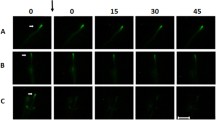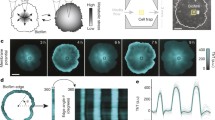Summary
This study explores natural ionic currents traversing hyphae and sporangia during the asexual life cycle of the mycelial water moldAchlya debaryana. Ionic current enters the extending hyphal apex at a density of 1–2μAcm−2 in the form of current spikes. Current normal to the surface enters hyphae up to 600 μm behind the growing tip. A large efflux of current lasting 1–2 minutes occurs during the homogeneous stage of sporangium development. Spore release is accompanied by a few spikes of inward current. The results obtained so far suggest that the developmental processes of hyphal elongation and sporangium formation in the asexual life cycle of water molds are correlated with particular ionic currents.
Similar content being viewed by others
References
Armbruster, B. L., 1980: Sporangiogenesis and spore discharge in members of theSaprolegniaceae. Ph.D. thesis, Duke University, Durham, N. Carolina.
—, 1982a: Sporangiogenesis in three genera of theSaprolegniaceae. I. Pre-sporangium hyphae to early primary spore initial stage. Mycologia74, 433–459.
-1982 b: Sporangiogenesis in three genera of theSaprolegniaceae. II. Primary spore initial to secondary spore initial stage. Mycologia: manuscript accepted.
Bartnicki-Garcia, S., 1973: Fundamental aspects of hyphal morphogenesis. In: Microbial Differentiation (Ashworth, J. M., Smith, J. E., ed.), 23rd Symposium, Soc. gen. Microbiol.23, 245–267. London: Cambridge Univ. Press.
Dorn, A., Weisenseel, M. H., 1982: Advances in vibrating probe techniques. Protoplasma113, 89–96.
Hartog, M. M., 1888: Recent researches on theSaprolegniaceae; a critical abstract of Rothert's results. Ann. Bot. (London)2, 201–216.
Heath, I. B., 1976: Ultrastructure of freshwater Phycomycetes. In: Recent Advances in Aquatic Mycology (Jones, E. B. G., ed.), pp. 603–650. London: Paul Elek.
Jaffe, L. F., 1966: Electrical currents through the developingFucus egg. Proc. Natl. Acad. Sci. U.S.A.56, 1102–1109.
—, 1981: The role of ion currents in establishing developmental gradients. In: International Cell Biology 1980–1981 (Schweiger, H. G., ed.), pp. 507–511. New York: Springer.
—,Nuccitelli, R., 1974: An ultrasensitive vibrating probe for measuring steady extracellular currents. J. Cell Biol.63, 614–628.
— —, 1977: Electrical controls of development. Ann. Rev. Biophys. Bioeng.6, 445–476.
Jaffe, L. F., Robinson, K. R., Nuccitelli, R., 1974: Local cation entry and self-electrophoresis as an intracellular localization mechanism. Ann. N.Y. Acad. Sci.238, 372–389.
Lovett, J. S., 1975: Growth and differentiation of the water moldBlastocladiella emersonii: cytodifferentiation and the role of ribonucleic acid and protein synthesis. Bacteriol. Rev.39, 345–404.
Rothert, W., 1892: Die Entwicklung der Sporangien bei der Saprolegnieen. Ein Beitrag zur Kenntnis der freien Zellbildung. Beitr. Biol. Pflanzen5, 291–349.
Slayman, C. L., 1965a: Electrical properties ofNeurospora crassa. Effects of external cations on the intracellular potential. J. gen. Physiol.49, 69–92.
—, 1965b: Electrical properties ofNeurospora crassa. Respiration and the intracellular potential. J. gen. Physiol.49, 93–116.
Stump, R. F., Robinson, K. R., Harold, R. L., Harold, F. M., 1980: Endogenous electrical currents in the water moldBlastocladiella emersonii during growth and sporulation. Proc. Natl. Acad. Sci. U.S.A.77, 6673–6677.
Weisenseel, M. H., Kicherer, R. M., 1981: Ionic currents as control mechanisms in cytomorphogenesis. In: Cytomorphogenesis in Plants. Cell Biology Monographs, Vol. 8 (Kiermayer, O., ed.), pp. 379–399. Wien-New York: Springer.
—,Dorn, A., Jaffe, L. F., 1979: Natural H+ currents traverse growing roots and root hairs of barley (Hordeum vulgare L.). Plant Physiol.64, 512–518.
—,Nuccitelli, R., Jaffe, L. F., 1975: Large electrical currents traverse growing pollen tubes. J. Cell Biol.66, 556–567.
Author information
Authors and Affiliations
Rights and permissions
About this article
Cite this article
Armbruster, B.L., Weisenseel, M.H. Ionic currents traverse growing hyphae and sporangia of the mycelial water moldAchlya debaryana . Protoplasma 115, 65–69 (1983). https://doi.org/10.1007/BF01293582
Received:
Accepted:
Issue Date:
DOI: https://doi.org/10.1007/BF01293582




